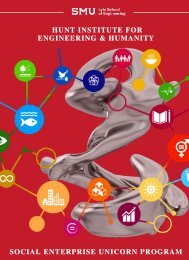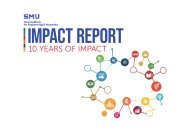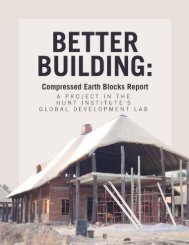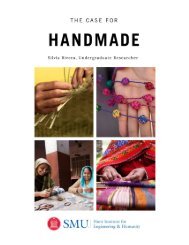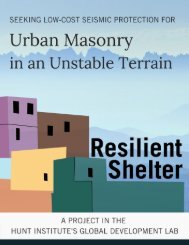Assessment of Rwanda Refugee Camps in the Context of the Villagization Process
Undergraduate researcher for the Hunt Institute for Engineering and Humanity and Engaged Learning Fellow Sienna Dugan, researched secondary sources and primary research through site visits, participatory observation, and interviews with key informants to compile this report which is structured like a case study with additional literature review. All photography is original to the student from her in-field research.
Undergraduate researcher for the Hunt Institute for Engineering and Humanity and Engaged Learning Fellow Sienna Dugan, researched secondary sources and primary research through site visits, participatory observation, and interviews with key informants to compile this report which is structured like a case study with additional literature review. All photography is original to the student from her in-field research.
Create successful ePaper yourself
Turn your PDF publications into a flip-book with our unique Google optimized e-Paper software.
1.2 Rwanda Background and CRRF
In 2015, political unrest peaked in Burundi displacing an estimated 400,000 people, many
of whom have sought shelter in Rwandan refugee camps. Generally, when refugee camps are
established, those seeking shelter within them often have only two choices. These include
voluntary repatriation for those brave enough to return home or resettlement in another
country.4 Because of the current global refugee crisis, an irregular and complex alternative has
started to be explored, the integration and nationalization of these refugees within their host
community.
This process has been standardized through the recent development of the
Comprehensive Refugee Response Framework (CRRF) which aims to ease pressures on host
countries; enhance refugee self-reliance; expand access to third-country solutions; and support
conditions in countries of origin for return in safety and dignity.5 Integration into communities
in response to “emergency development” have been documented through the process of
settlement programs, most notably in Ethiopia and Tanzania. Before integration policies are
implemented, it is instrumental that the communities are first transformed to independently
meet the Sphere guidelines of sustainability. 6 These guidelines focus on the four areas of
response: water supply, sanitation and hygiene promotion (WASH); food security and nutrition;
shelter and settlement; and health. In order to offer support in these sectors in alignment with the
CRRF framework, partner agencies and government counterparts are working to implement
4 UNHCR Policy Framework and Implementation Strategy: UNHCRs Role in Support of the Return and Reintegration of Displaced Populations:
, August 2008. (2009). Refugee Survey Quarterly,28(1), 205-221. doi:10.1093/rsq/hdp011
5 United Nations. “Comprehensive Refugee Response Framework.” UNHCR, 2018, www.unhcr.org/comprehensive-refugee-responseframework-crrf.html.
6 Project, T. S. (2011). Humanitarian Charter and Minimum Standards in Humanitarian Response. doi:10.3362/9781908176202
9




